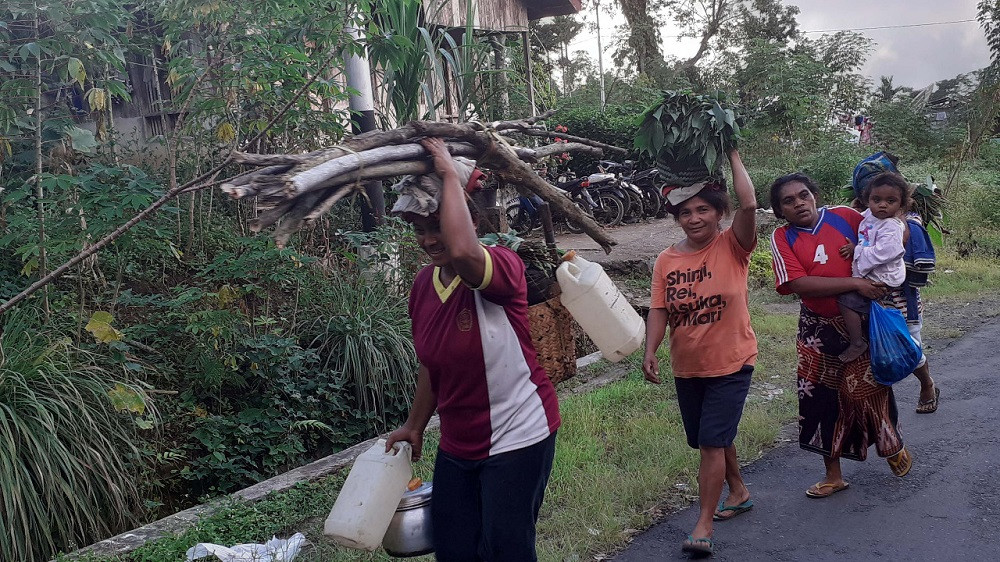Popular Reads
Top Results
Can't find what you're looking for?
View all search resultsPopular Reads
Top Results
Can't find what you're looking for?
View all search resultsThe disparity of gig economy and rural-urban poverty
The gig economy is mainly concentrated in urban areas, where people are no longer in the process of catching up — they are already there. The urban gig workers, which dominated the roughly 5 percent of total gig workers in Indonesia, were among the main recipients of negative effects of COVID-19.
Change text size
Gift Premium Articles
to Anyone
"We know what can end poverty. But how come poverty never diminish?” — was the reply I received from my friend, Harry, who works as a gig worker in a city in Scotland when we were discussing about poverty. The reason I specify his identity is because it is significant to what I am about to elaborate.
Indonesia’s rural poverty has always been higher than urban poverty. In September 2019, urban and rural poverty hit 9.86 million and 14.93 million, respectively. But when the pandemic struck, it has plunged more households into poverty. As of March 2020, urban and rural poverty were 11.16 million and 15.26 million, respectively.
The spike in rural poverty was not as high as urban poverty. Does this mean the urban communities are more prone to external shocks? Maybe. But we should dig deeper, deeper, and deeper.
Based on Statistics Indonesia (BPS) database, there is not much disparity between urban and rural areas in terms of bi-annual poverty trends. Even though poverty is much higher in Indonesian villages than in cities, the pace is quite similar. So, what makes March 2020 different? Both areas were hit by the same pandemic, but why did the spike in urban poverty quadruple the rise in rural poverty?
There might be a lot of plausible reasons behind this, but perhaps we should examine what has been sitting in front of our faces: the unequal geography of the gig economy in Indonesia, which, in the case of COVID-19, protects rural areas from more poverty cases.
The gig economy is mainly concentrated in urban areas, where people are no longer in the process of catching up — they are already there. The urban gig workers, which dominated the roughly 5 percent of total gig workers in Indonesia, were among the main recipients of negative effects of COVID-19.
On the other hand, Indonesia still has much homework to do for its villages. The needs to improve infrastructures, good quality of education, access to health services — which can pave the way to ending poverty. The slow progress in meeting these needs lead to an automatic rejection to — or slow absorption of — innovations in terms of employment or economic activities. The low concentration of the gig economy in rural areas correspond to a small effect of COVID-19 on rural households whose incomes are slightly above the poverty line.
So, what does this figure tell us about the nature of the gig economy and poverty in Indonesia? The answers are threefold.
First, gig economy work in Indonesia is extremely fragile — it exposes its workers to risks of living in poverty after giving them a taste of heaven for a split-second. Gig workers can be independent contractors or contract firm workers at big firms, other forms of temporary workers, or online platform workers. The new poor in urban Indonesia mainly came from online platform workers.
Digital labor platforms, such as ride-hailing services, were supposed to bring more job opportunities to low-income families. And that was at least what we thought what happened. Nevertheless, by seeing the concentration of digital innovation, it looks as if profit always outweighs any social motive.
Second, the disproportionate level of the gig economy between rural and urban Indonesia signifies the low level of innovation in rural Indonesia. Although in the case of COVID-19, the lack of innovation acted as a buffer against poverty, it might also be the reason behind rural Indonesia’s slow progress in reducing poverty. Innovation has a blank face.
Whether it turns out to be good or bad, it depends on how we make use of it. Therefore, before intensifying innovation in rural areas, the government ought to design a form of social protection policy for all kinds of gig laborers.
This is our life now. The life we have prior to digital innovation has become a history. We can study it, but we no longer live in that period.
Third, it is time to put an end to stigmatization against rural communities. That they are backward, have low ability to succeed, that rural is poor. Regardless of which province or which country it is located, it seems as if rural is associated with a third-world nation. Looking at the unequal geography of the gig economy, another reason why innovative project rarely wants to target rural areas is because of these prejudices.
Whether we want it or not, temporary and remote workings are becoming the new normal. It will eventually reach all Indonesian villages. However, even if we already know what is going to happen, there is no harm in preparing an elaborate plan. Because odds are, digital innovation in rural areas will intensify inequality of income and deepen poverty.
Local governments in rural areas, while must promote innovation, should also prepare the buffers which will protect gig workers from economic turbulence and smoothen the transition to the gig economy.
To begin with, local governments must build the foundation of knowledge of employment innovation. This includes creating a mechanism which will bring equality between gig and non-gig workers, such as a shared responsibility of social protection between rural governments and the employers if the workers come from poor or low-income families.
Harry’s responses, although not entirely accurate, bear some truth inside. We know that education is the key to poverty eradication and access to finance can expand people’s mobility and improve their livelihood.
Policymakers know about all these, yet the reason why poverty rate remains high is that the policymakers tend to be forgetful in adapting poverty alleviation policies to contemporary forms of livelihood. Accurate poverty-targeting strategies are not merely about serving those who live below the poverty line; they are about understanding poverty. And the gig economy is one of the many faces of poverty.
The urban gig workers, which dominated the roughly 5 percent of total gig workers in Indonesia, were among the main recipients of negative effects of COVID-19.
***
PhD candidate at London School of Economics and Political Science (LSE)










